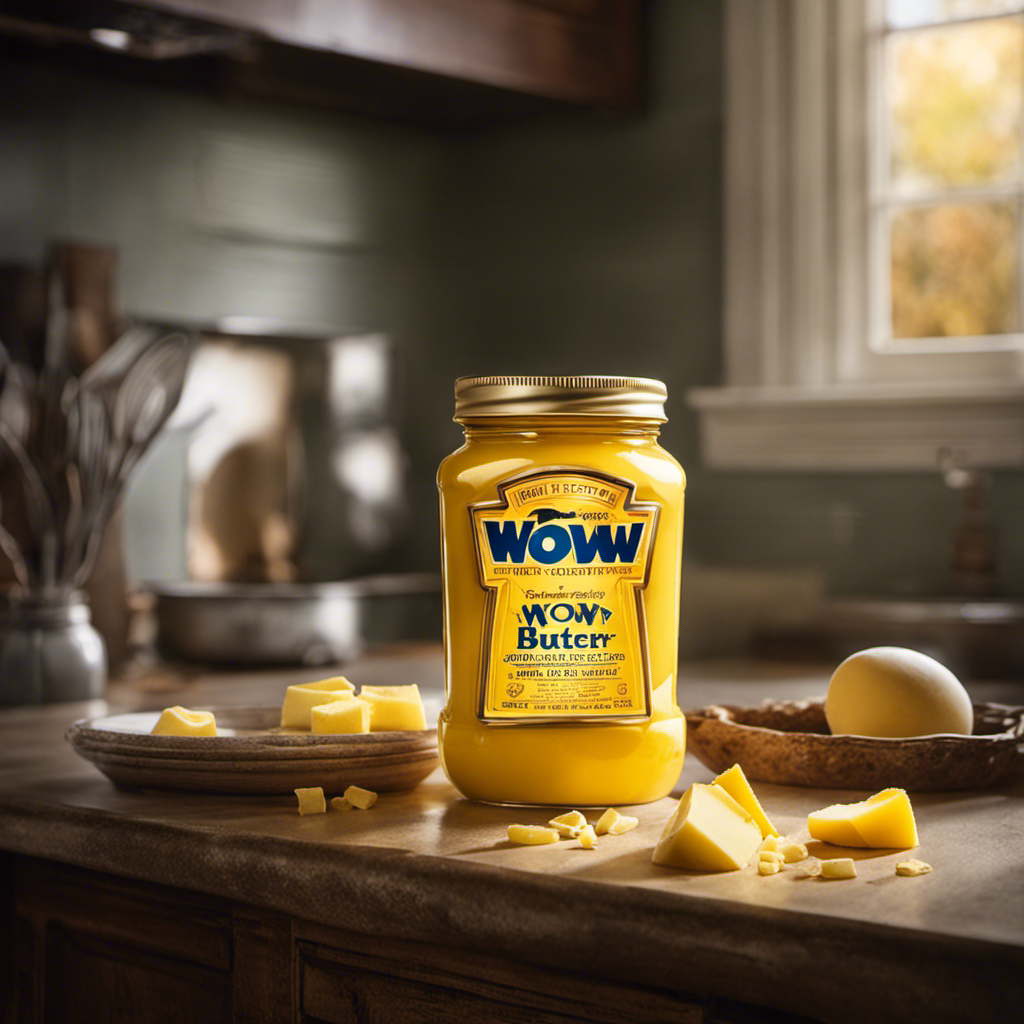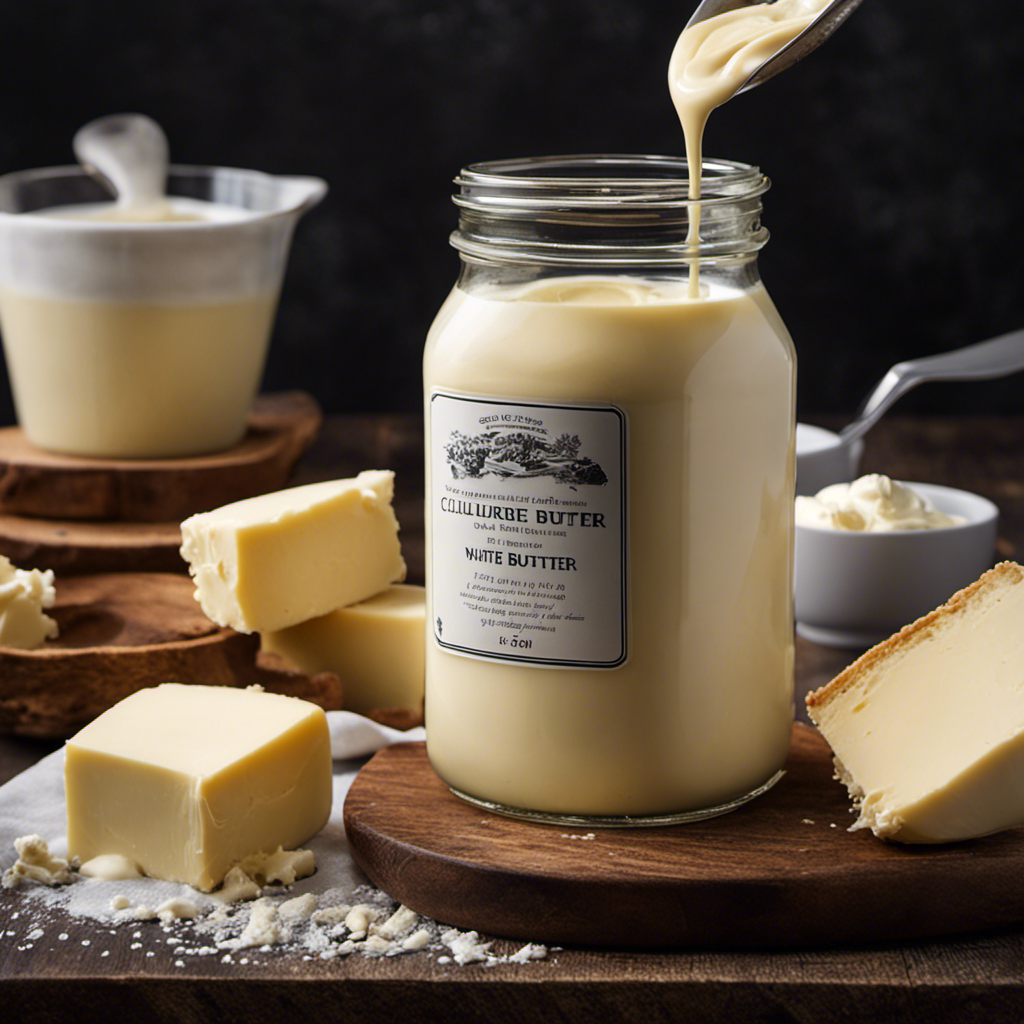Oh my goodness, I have to say, the journey of Wow Butter has been a wild rollercoaster of ups and downs.
It’s crazy to think about how a product that seemed to be flying high just a few years ago has disappeared from the market entirely.
In this article, we will explore the key events that led to Wow Butter’s decline, the challenges it faced in the competitive market, and the factors that ultimately contributed to its disappearance.
So buckle up and get ready to dive into the fascinating saga of Wow Butter.
Key Takeaways
- Wow Butter initially had success due to its unique marketing strategy targeting individuals with peanut allergies and health-conscious consumers.
- The recall of a contaminated batch eroded consumer trust in Wow Butter’s ability to provide allergen-free products, leading to negative publicity.
- Increased competition from other companies offering peanut butter alternatives, as well as the rise of alternative nut and seed butters, impacted Wow Butter’s sales.
- Wow Butter failed to differentiate itself from competitors and adapt to changing consumer demands, ultimately leading to its disappearance from the market.
The Rise and Fall of Wow Butter
The rise and fall of Wow Butter has been a roller coaster of success and disappointment. Wow Butter, a peanut butter alternative made from soy, entered the market with a unique marketing strategy that aimed to target both individuals with peanut allergies and health-conscious consumers.
Their marketing campaign highlighted the product’s allergy-friendly nature and its nutritional benefits. This strategy initially proved successful, as Wow Butter gained popularity among those looking for peanut-free alternatives and individuals seeking a healthier option.
However, Wow Butter’s success was short-lived. Despite its initial impact, the product faced challenges in maintaining its market position. As more companies started to offer peanut butter alternatives, Wow Butter struggled to stand out. Additionally, the peanut butter industry as a whole saw a decline in demand, further impacting Wow Butter’s sales.
Ultimately, Wow Butter’s marketing strategy and the changing dynamics of the peanut butter industry played a significant role in its rise and fall.
Key Events That Led to Wow Butter’s Decline
One of the key events that contributed to Wow Butter’s decline was the recall of a contaminated batch. This incident not only affected the reputation of the brand but also raised concerns about food allergy awareness and product safety.
Here are four factors that played a role in Wow Butter’s downfall:
-
Contamination: The recall of a contaminated batch exposed a major flaw in Wow Butter’s production process, leading to doubts about the overall quality and safety of their products.
-
Loss of trust: The recall eroded consumer confidence in Wow Butter’s ability to provide allergen-free products, causing many loyal customers to switch to alternative brands.
-
Negative publicity: News of the recall spread quickly, resulting in widespread negative publicity for Wow Butter. This further damaged their reputation and made it difficult to attract new customers.
-
Increased competition: As food allergy awareness grew, more companies started offering peanut butter alternatives. Wow Butter faced stiff competition from both established brands and emerging startups, making it harder to regain their market share.
Overall, the recall of a contaminated batch was a significant event that contributed to Wow Butter’s decline. It highlighted the importance of food allergy awareness and the need for strict quality control measures in the food industry.
Challenges Faced by Wow Butter in the Market
Facing fierce competition and a loss of consumer trust, Wow Butter struggled to regain its market share.
The food industry challenges that Wow Butter faced were numerous. Firstly, the rise of alternative nut and seed butters presented a significant threat to Wow Butter’s position in the market. Consumers were becoming more health-conscious and sought out healthier options, which led to the popularity of almond, cashew, and sunflower seed butters.
Additionally, the food industry faced increasing scrutiny regarding food allergies and allergen labeling. Wow Butter’s marketing strategies needed to address these concerns and regain consumer trust. They implemented transparent labeling and emphasized their product’s safety and allergen-free nature.
However, despite these efforts, Wow Butter still faced hurdles in regaining its market share. They needed to focus on innovative marketing strategies that highlighted the unique qualities of their product and differentiated themselves from their competitors.
Factors Contributing to Wow Butter’s Disappearance
To understand what led to Wow Butter’s disappearance, you must consider the factors that contributed to it. Here are the key factors that played a role in Wow Butter’s downfall:
-
Food Allergy Awareness: With increasing awareness and concern about food allergies, consumers became more cautious about the products they purchased. Wow Butter, being a peanut butter alternative, faced tough competition from other allergy-friendly brands.
-
Product Recalls: There were instances where Wow Butter had to recall their products due to potential allergen contamination or manufacturing issues. These recalls damaged the brand’s reputation and eroded consumer trust.
-
Market Saturation: The market for allergy-friendly food products became saturated with numerous alternatives, making it harder for Wow Butter to stand out and attract customers.
-
Lack of Innovation: Wow Butter failed to introduce new and exciting products or adapt to changing consumer demands, which resulted in a decline in sales and ultimately led to its disappearance.
Considering these factors, it is evident that Wow Butter faced significant challenges in a competitive market driven by food allergy awareness and product recalls.
Transitioning into the next section, let’s explore the lessons learned from the Wow Butter saga.
Lessons Learned From the Wow Butter Saga
When examining the lessons learned from the Wow Butter saga, it is crucial to discuss the importance of food allergy labeling, consumer trust and safety, and brand reputation management.
Firstly, food allergy labeling plays a vital role in ensuring the safety and well-being of consumers, especially those with severe allergies. Without clear and accurate labeling, individuals may unknowingly consume allergens, leading to potentially life-threatening reactions.
Secondly, the incident highlighted the significance of consumer trust and safety, as Wow Butter’s mislabeled product not only put consumers at risk but also eroded their trust in the brand.
Lastly, brand reputation management is essential in handling crises and maintaining a positive image within the market. The way a company responds to such incidents can significantly impact its reputation and future success.
Food Allergy Labeling
The new food allergy labeling regulations will ensure consumers are well-informed about potential allergens in products like Wow Butter. This is an important development given the prevalence of food allergies and the need for clear information to make safe choices.
Here are four key aspects of the new regulations:
-
Mandatory allergen labeling: Companies will be required to clearly label the presence of common allergens such as peanuts, tree nuts, dairy, soy, and wheat on their products.
-
Consistent format: The regulations will establish a standardized format for allergen information, making it easier for consumers to identify and compare products.
-
Clear language: The labeling must use simple and concise language to describe potential allergens, ensuring that consumers can understand the information easily.
-
Cross-contamination warnings: Manufacturers will also be required to include warnings about potential cross-contamination with allergens during the production process.
Consumer Trust and Safety
You can ensure your safety and build trust with food companies by looking for products that clearly label allergens and follow consistent format guidelines.
Consumer education is key when it comes to understanding the potential risks associated with food allergies. By being informed about the ingredients and allergens present in the products we consume, we can make better choices for our health.
Additionally, it is important for food companies to take responsibility for the safety of their consumers by implementing effective product recalls in the event of contamination or mislabeling. These recalls not only protect consumers but also demonstrate a commitment to transparency and accountability.
Ultimately, by prioritizing consumer safety and trust, food companies can effectively manage their brand reputation and maintain the loyalty of their customers.
Brand Reputation Management
To effectively manage your brand reputation, it’s important to prioritize consumer safety and trust. In today’s fast-paced and interconnected world, any misstep can quickly lead to a crisis that can damage your brand’s reputation. Here are four key steps to effective brand reputation management:
-
Monitor online conversations: Stay vigilant by monitoring social media, review sites, and news outlets to identify any potential issues or negative sentiment towards your brand.
-
Respond promptly and transparently: When a crisis arises, address it promptly and honestly. Be transparent about the issue, communicate your actions to resolve it, and show genuine concern for the well-being of your customers.
-
Engage with your audience: Actively engage with your customers, both online and offline. By building strong relationships and providing exceptional customer service, you can foster trust and loyalty, which can help protect your brand reputation during a crisis.
-
Learn from your mistakes: Use any crisis as an opportunity for learning and improvement. Evaluate what went wrong, identify areas for improvement, and implement changes to prevent similar incidents in the future.
What the Future Holds for Wow Butter
Looking ahead, it’s interesting to consider the future innovations that Wow Butter may bring to the market. With its unique formulation and potential for varied applications, Wow Butter has the opportunity to continue to expand its product offerings and cater to a wider customer base.
However, as the popularity of alternative nut butters continues to grow, Wow Butter will also face increased market competition. This will require them to stay ahead of the curve with new and innovative products.
Wow Butter’s Future Innovations
Wow Butter’s future innovations include creating new flavors and improving their packaging to better meet the needs of their customers. Here are some key developments that Wow Butter has in store for their product development and marketing strategy:
-
New Flavors: Wow Butter is constantly working on creating new and exciting flavors to cater to different taste preferences. They understand that their customers may have diverse preferences, so they strive to offer a wide range of options.
-
Improved Packaging: Wow Butter is committed to improving their packaging to ensure the product remains fresh and easy to use. They are exploring innovative packaging solutions that will make it more convenient for customers to enjoy their products.
-
Enhanced Nutritional Profile: Wow Butter is focused on improving the nutritional value of their products. They are researching ways to increase the protein content and reduce sugar and sodium levels, ensuring that their products are not only delicious but also nutritious.
-
Targeted Marketing Campaigns: Wow Butter is planning to implement targeted marketing strategies to reach a wider audience. They will utilize social media platforms and collaborate with influencers to promote their products and engage with their customers.
With these future innovations, Wow Butter aims to continue providing high-quality products that meet the evolving needs and preferences of their customers.
Market Competition for Wow Butter
In the market competition, Wow Butter faces challenges from other brands that offer similar peanut butter alternatives. These brands are also capitalizing on the growing demand for healthier products and the increasing number of consumers with peanut allergies.
To stay ahead in this competitive landscape, Wow Butter needs to understand current market trends and focus on product differentiation. By analyzing market trends, Wow Butter can identify the preferences and needs of its target audience. This will enable them to develop unique features or flavors that set their product apart from competitors.
Additionally, Wow Butter can invest in marketing strategies that highlight the health benefits of their alternative peanut butter, such as being free from peanuts and allergens. By effectively differentiating their product, Wow Butter can maintain and grow its market share in the face of intense competition.
Frequently Asked Questions
How Did Wow Butter’s Decline Impact the Overall Nut Butter Industry?
Wow Butter’s decline had a significant impact on the overall nut butter industry. The competitive landscape shifted as other brands seized the opportunity to capture market share. Additionally, consumer behavior changed as people sought alternative nut butter options.
What Were Some Potential Strategies Wow Butter Could Have Implemented to Avoid Their Downfall?
To avoid their downfall, Wow Butter could have implemented potential strategies such as diversifying their product line, improving their marketing tactics, and strengthening their supply chain. These strategies could have helped them navigate the challenges they faced.
Did Wow Butter Face Any Legal Issues During Their Decline?
Yes, Wow Butter faced legal challenges during their decline. There were lawsuits against Wow Butter, which contributed to their downfall. These legal issues had a significant impact on the company’s reputation and financial stability.
Were There Any Specific Market Trends That Influenced Wow Butter’s Disappearance?
Market trends and consumer preferences played a significant role in Wow Butter’s disappearance. As the market shifted towards healthier alternatives and nut-free options, the demand for Wow Butter declined, leading to its eventual downfall.
How Did Wow Butter’s Disappearance Affect Its Employees and Suppliers?
The disappearance of Wow Butter had a significant impact on its employees and suppliers. The job market was affected as employees lost their jobs, leading to financial consequences for both individuals and businesses involved.
Conclusion
In conclusion, the story of Wow Butter serves as a cautionary tale for businesses in the competitive market.
Despite its initial success and popularity, the company faced numerous challenges that ultimately led to its downfall. From ingredient controversies to market saturation, Wow Butter struggled to maintain its position.
However, the lessons learned from this saga can guide future entrepreneurs in making informed decisions and adapting to changing market dynamics.
As the old adage goes, ‘It’s not about how you start, but how you finish.’ The future of Wow Butter remains uncertain, but the company’s journey offers valuable insights for the business world.










